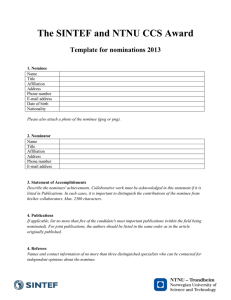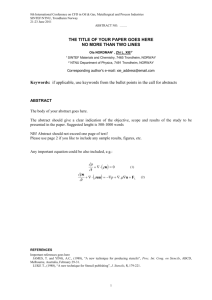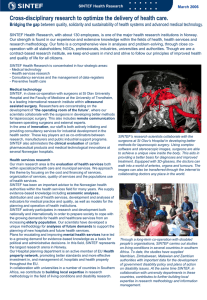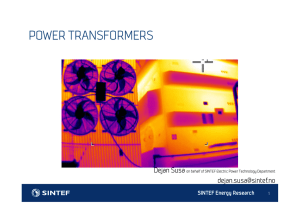Superconducting Generator Technology for Large Offshore
advertisement
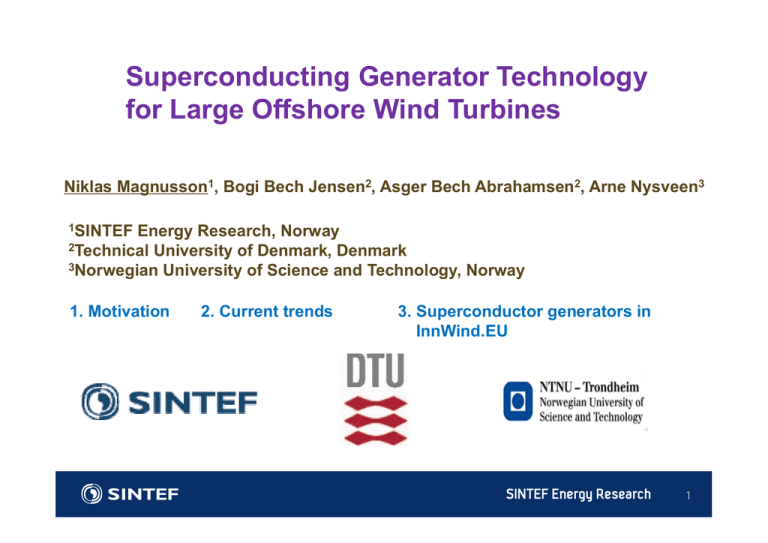
Superconducting Generator Technology for Large Offshore Wind Turbines Niklas Magnusson1, Bogi Bech Jensen2, Asger Bech Abrahamsen2, Arne Nysveen3 1SINTEF Energy Research, Norway 2Technical University of Denmark, Denmark 3Norwegian University of Science and Technology, Norway 1. Motivation 2. Current trends 3. Superconductor generators in InnWind.EU SINTEF Energy Research 1 Motivation • Weight and volume reductions • Practically rare earth metal independent In the end, it is all about costs SINTEF Energy Research 2 Superconductors • Materials that carry large DC current densities lossfree at low temperatures • Exhibit losses under AC operation • Widely used in MRI diagnostics equipment at hospitals • Under evaluation for several large scale power applications SINTEF Energy Research 3 The concept • Rotor field generated by superconducting coils at cryogenic temperatures • Stator (armature) windings composed of copper conductors at room temperature B.B. Jensen et al., 2nd International Conference E/E Systems for Wind Turbines, Bremen, 2012 Abrahamsen et al., SUST23, 034019, 2010 SINTEF Energy Research 4 Volume and weight is magnetic field dependent • P=ωτ ω is the angular frequency (given by maximum tip speed) τ is the torque • τ∝BIV B is the air gap magnetic field I is the stator current (given by stator constraints) V is the generator volume The only variables to play with are the magnetic field strength and the volume SINTEF Energy Research 5 Volume and weight: Superconductor versus permanent magnets • Permanent magnet air gap flux density ~ 1 T • Superconductor air gap flux density ~ 2.5 T • Superconductor generator volume 40% less than corresponding permanent magnet generator Additionally, the superconductor field windings are light weighted. SINTEF Energy Research 6 Rare earth metal dependency: Superconductor versus permanent magnets 10 MW generator: • Permanent magnet based: 6 ton RE PM • Superconductor based: 10 kg RE in HTS A permanent magnet based off-shore generator technology would double the world market for such magnets SINTEF Energy Research 7 The superconductor possibility – Current trends in research Choosing superconductor • Choice of operating temperature, magnetic field strength, cost and availability • Superconducting wires are under development – increasing performance, reducing costs Several actors – several concepts SINTEF Energy Research 8 Conductors Material type Operating temperature Magnetic field Current density Cost 2012 Cost 2020 (at large scale deployment) NbTi 4.2 K 5T 1000 A/mm2 1 €/kAm 1 €/kAm YBCO 40 K 3T 200 A/mm2 300 €/kAm 30 €/kAm MgB2 20 K 3T 200 A/mm2 10 €/kAm 3 €/kAm Cu 50°C <1T 4 A/mm2 50 €/kAm 50 €/kAm Generator activities Material type Transmission Power rating Industrial interest NbTi Direct drive 10 MW General Electric YBCO Direct drive 10-15 MW AMSC MgB2 Direct drive 10 MW Advanced Magnet Lab European consortia – Suprapower, InnWind.EU SINTEF Energy Research 9 Energy B. B. Jensen, N. Mijatovic, A. B. Abrahamsen, European Wind EnergySINTEF Conference & Exhibition, Research Copenhagen, 2012 10 Energy B. B. Jensen, N. Mijatovic, A. B. Abrahamsen, European Wind EnergySINTEF Conference & Exhibition, Research Copenhagen, 2012 11 SINTEF Energy Research B. B. Jensen, N. Mijatovic, A. B. Abrahamsen, European Wind Energy Conference & Exhibition, Copenhagen, 2012 12 INNWIND.EU Aiming at integrated wind turbine concepts with: • Light weight rotor • Low-weight, direct drive generator • Standard mass-produced tower and substructure • Design of 10-20 MW concepts • Hardware demonstrators of critical components A joint European effort with more than 25 partners SINTEF Energy Research 13 INNWIND.EU MgB2 superconducting rotor coils • MgB2 superconductors from multiple producers • Scaled race-track coils Evaluating key components H. Taxt et al., IEEE Trans. Appl. Supercond. 23, 8200204, 2013 A.B. Abrahamsen, et al., Physica C 471, 1464–1469, 2011 SINTEF Energy Research 14 INNWIND.EU MgB2 superconducting rotor coils • Testing at full-scale thermal and electromagnetic conditions • 15-20 K, 3-4 T, 200 A/mm2 Taking advantage of existing magnet technology SINTEF Energy Research 15 Summary • Superconducting generators may reduce volume and weight • Material development intensive • Basic design concept under evaluation • Reliability to be proven • Cost is both the prime concern and the prime driver SINTEF Energy Research 16
